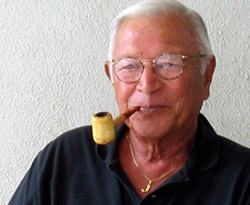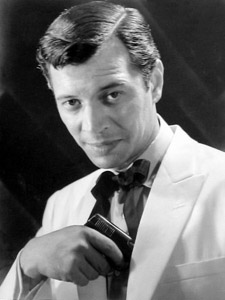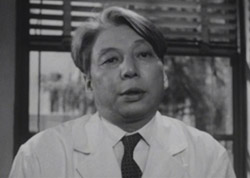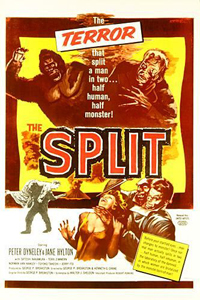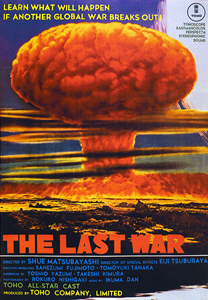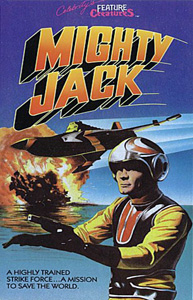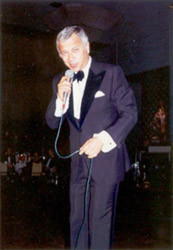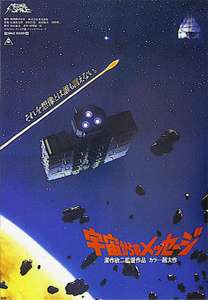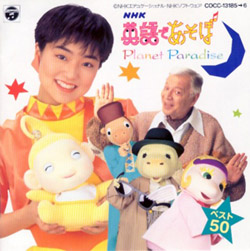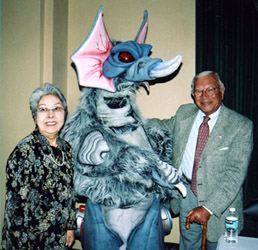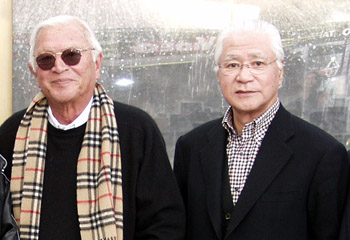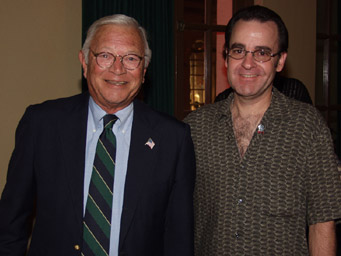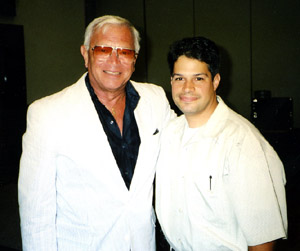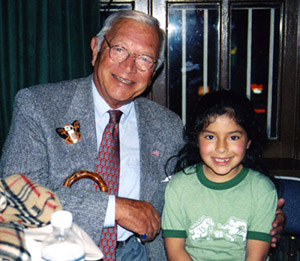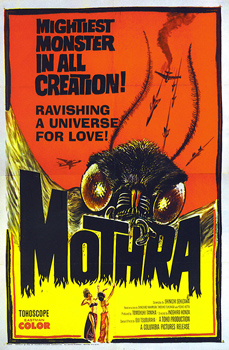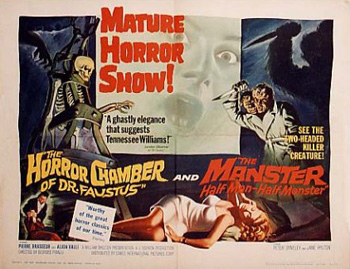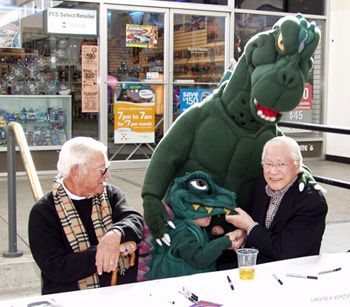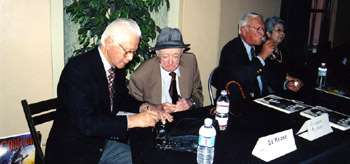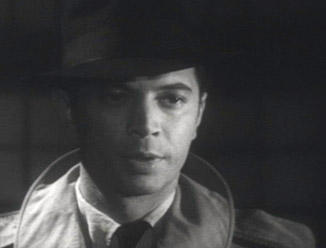A Tribute to the Star of MOTHRA Author: Keith Aiken and Steve Ryfle Additional Material: Bob Johnson and Clay Holden Translations: Oki Miyano and Chieko Tsuneoka Special thanks to Hiroshi Koizumi, Michele Ito, Shinichi Wakasa, Shigeko Kojima, Loren Portillo, Kayo Holden, Stuart Galbraith IV, Fred Olen Ray, and Jim Ballard
- Friends and Fans Remember Jerry Ito...
- Jerry Sings "Fly Me to the Moon"
- Video from THE MANSTER and Godzillafest
On July 29 a memorial service was held in honor of actor and singer Jerry Ito, who passed away earlier this month at age 79. Family and friends gathered in the Garden Room of the Japanese American Cultural and Community Center of Los Angeles to share stories and memories of their departed loved one. To movie fans, Jerry Ito is familiar for his roles in Japanese science fiction films like THE MANSTER, THE LAST WAR, and MOTHRA, but he was better known in Japan as a singer and entertainer who regularly appeared on television. Jerry also performed on stage both in Japan and on Broadway, and was a popular commercial pitchman in the 1970s. People close to him knew Jerry as a patriot who loved the United States of America and proudly fought for his country in both the Army and the Navy. Surprisingly little of Jerry’s life has been written about, either in the US or Japan. In his memory we present his story, told in Jerry’s own words and supplemented by anecdotes and personal messages from his friends and family, as well as rare personal photographs and video of Jerry onstage at the 2004 Godzillafest in San Francisco... Jerry Ito is introduced at Godzillafest, November 2004
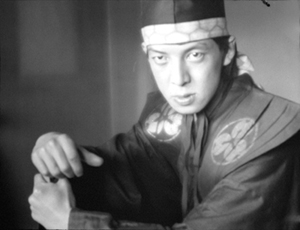 Jerry Ito`s father, renowned dancer Michio Ito, circa 1916. Photo by Alvin Langdon Coburn, from the George Eastman House collection.
Jerry Ito`s father, renowned dancer Michio Ito, circa 1916. Photo by Alvin Langdon Coburn, from the George Eastman House collection.Jerry Ito was born into a family of entertainers. His father was the internationally renowned dancer and choreographer Michio Ito. Born April 13, 1892, the elder Ito had learned traditional dance in his native Japan before moving to Germany at age 19 to study for the opera. Michio Ito soon realized he didn’t have an operatic voice so he instead turned his attention to the new wave of modern dance that had recently begun in Europe. World War I began in 1914 and— with Germany and Japan on opposite sides of the conflict— he was forced to leave the country. Michio resettled in Switzerland to continue his studies and also started dancing in Paris and London where he became friends with many composers, writers, and artists, including authors Ezra Pound and William Butler Yeats. In 1915, he choreographed Yeats` play AT THE HAWK’S WELL, which had been inspired by traditional Japanese Noh Theater. The following year, Michio Ito was brought to the United States to choreograph a show on Broadway. For the next decade he moved back and forth between New York and Hollywood, where he worked on movies like DAWN OF THE EAST (1921), MADAME BUTTERFLY (1933), and SPAWN OF THE NORTH (1938) with George Raft, Henry Fonda, and Dorothy Lamour. He also continued to choreograph and perform modern dance pieces with his own dance troupe, which included his wife, Hazel Agnes Wright. Following the birth of their son Donald, the couple`s second son Gerald Tamekichi Ito was born in New York City on July 12, 1927. When Jerry was 2 years old the family moved to California. His childhood friend Barbara Perry fondly recalled that Donald Ito was quiet, polite, and reserved while the younger Jerry was more outgoing and mischievous. Perry, who was a member of Michio Ito`s dance troupe, remembered a time when Jerry disappeared during rehearsals for a dance recital at the Hollywood Bowl. While his family searched for the small boy, Jerry snuck onto the conductor`s stand and began to lead the orchestra.
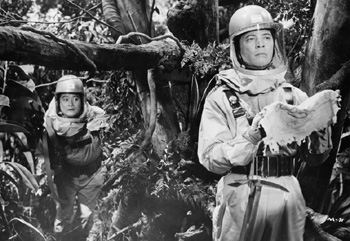 Publicity photo for MOTHRA showing Frankie Sakai and Jerry Ito on Beiru Island. © 1961 Toho Co., Ltd.
Publicity photo for MOTHRA showing Frankie Sakai and Jerry Ito on Beiru Island. © 1961 Toho Co., Ltd.Jerry`s parents divorced in 1935. Shortly after the start of World War II, Michio Ito was arrested by the FBI and accused of spying against the United States. Rather than be falsely prosecuted, Michio decided to return to Japan. “My father went back to Japan during the war on an exchange ship,” Jerry explained in a September, 2004 interview. “Some Americans were caught in Japan and they wanted to go home, and some of the Japanese living in America wanted to go back to Japan, and my father was one of them. So they had these exchanges after the war broke out. He spent the entire war in Japan.” Being half-Japanese, Jerry would have been required to live in a resettlement camp if he had remained in California, so his uncle and aunt took him back to New York. He lived with his relatives in Greenwich Village until he finished high school and was drafted into the Navy. Despite his personal ties to Japan and the mistreatment of his father, Jerry was eager to fight for America. “When the war broke out, I was so surprised, but I wanted to go into the service immediately. Even to this day I feel the same.” Jerry ended up being part of the first Occupation forces into Japan. He spent four months there, first in Sasebo on the island of Kyushu, and later in Yokosuka, an hour outside of Tokyo. Jerry and Michio Ito had lost contact during the war, and he didn’t know if his father was living or dead. While stationed in Yokosuka, Jerry would use his shore leaves to go into Tokyo to find his father. At that time, he couldn’t speak any Japanese, so he went from one theater to the next and would ask if anyone knew Michio Ito. “Nobody could understand me, or they didn’t want to understand me,” he laughed. After several months of fruitless searching, he approached a Nisei colonel from the U.S. Army. “My father was a big name in California, so I asked him, ‘Do you know Michio Ito?’ And he said, ‘Oh, Mike! Yeah, he’s over at the Ernie Pyle Theater!’”
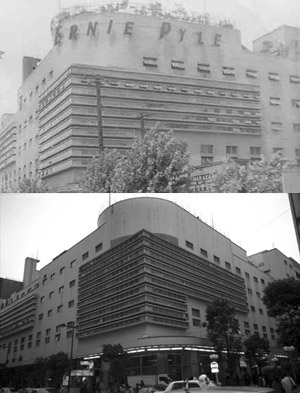 The Tokyo Takarazuka Theater was renamed the Ernie Pyle Theater during the US Occupation. The building was demolished in the 1990s and replaced with a new state-of-the-art Takarazuka Theater.
The Tokyo Takarazuka Theater was renamed the Ernie Pyle Theater during the US Occupation. The building was demolished in the 1990s and replaced with a new state-of-the-art Takarazuka Theater.The Ernie Pyle Theater was actually the Takarazuka Theater, home of the famous women’s acting troupe. During the Occupation, the theater was temporarily renamed and was only open to G.I.’s. Michio Ito had an office on the fourth floor of the theater, but he was not in the day Jerry visited. Michio’s secretaries explained that he was home, but there was no phone there. “They drew a map of Onikubo; that was the place where he was living. They drew a pine tree, and under the pine tree was my dad’s house. So I went there, and got off the train at the station, and wherever I looked there were pines all over the place.” Near the train station there were shops and fish markets, and Jerry went into one after another to inquire about his father. Eventually he met a man who was friends with Jerry’s uncle, Kanai Ito. “We got on the train to Shibuya, and this guy brought me right to the door, which was very nice of him. So I met my aunt and uncle and cousins there.” Jerry soon had to return to Yokosuka, so he made plans to meet his father the next day. But he was late getting back to his ship and was given an automatic one-week restriction. It wasn’t until the following week that he could return to his family. Jerry described that moment: “My father was there, every uncle and aunt were there. They had been meeting every day for a week; they were waiting for me. It was a wonderful gift to be able to see my father and all of them. My father said, ‘Well, Jerry, Tokyo is my town. What do you want to do?’ I didn’t want to do anything but see him. I hadn’t seen him all during the war.” After finishing with the Navy, Jerry went to New York on the G.I. Bill and attended the New School for Social Research, whose alumni include such stars as Tony Curtis, Harry Belafonte, and Walter Matthau. There he studied acting under Irwin Fitzwater, who was head of the Epic Theatre, a non-profit organization dedicated to the arts. Two years into his studies he got his first Broadway show, Robert Penn Warren’s ALL THE KING’S MEN. Shortly after the play wrapped, Jerry received another letter from the draft board, which was a surprise since he had an honorable discharge from the U.S. Navy. It turned out the military felt Jerry’s 11 months in the service was not sufficient so he was recalled to duty. “So I said, ‘You want to send me back into the Navy?’, and then they said, ‘No, you’re going into the Army!`"
Jerry was sent to Fort Dix, New Jersey for six weeks of basic training. While there, the director of soldier’s shows for Fort Dix recognized him from ALL THE KING’S MEN. Jerry was brought into Special Services, which handled military service clubs, theaters, and sports teams. At that time, the Colonel in charge of Special Services had decided to “clean up” the soldier’s shows by giving any homosexual soldiers a dishonorable discharge or the option to serve in Korea. This depleted the Special Services, and Jerry’s first job upon arrival was to find new people to fill the ranks. He auditioned dancers and drama students, and also recruited well-known enlisted entertainers like singer/actor Vic Damone (KISMET). They put on shows at Fort Dix and the Center Theatre in New York City, and Jerry also supervised the “100 Nights” show at West Point. By then he only had a few months of service left. The Army couldn’t ship a soldier to Korea if they had less than six months, so Jerry spent his time at Fort Dix. “When it was over, the Colonel asked me if I would re-enlist. I said, ‘Hell, no! I’m going back to New York!’” In 1953, Jerry returned to Broadway with TEAHOUSE OF THE AUGUST MOON at the Martin Beck Theater (now the Al Hirschfeld Theater). He stayed with the show for two and a half years. Early in 1954, Jerry received a letter from his father telling him that a large group of Japanese dancers, the Azuma Kabuki Dancers and Musicians, would be performing on Broadway that February. Michio Ito asked his son to look after the dancers during their time in New York, so Jerry went to see the group at the New Century Theatre. There he met a young dancer named Sakae Yamaguchi, who performed under the stage name Wakana Hanayanagi. The two hit it off, and they saw each other again the following year when the Azuma Kabuki Dancers did a second tour. But Jerry had a girlfriend at the time, and Sakae was engaged to be married. The two wished each other well and went their separate ways. During his run on TEAHOUSE, Jerry received a call from director Sidney Lumet (12 ANGRY MEN, DOG DAY AFTERNOON, NETWORK). Lumet was one of a group of directors working on YOU ARE THERE, a popular CBS television series which re-enacted famous moments in history as if they were live news broadcasts, and he invited Jerry to audition for the part of a Filipino guerrilla fighter for the episode “The Surrender of Corregidor”. Jerry recalled, “So I walked into the casting office and all I saw was Filipinos, and I knew I wasn’t going to get the part. [Laughs] So they gave me the script, and then Sidney Lumet said something to me that really helped me nail the part. He said, ‘This character is a hero, but don’t play it like a hero.’ So I got about two or three minutes to go through the script, and then I did my reading. They said, ‘Thank you very much, we’ll call you.’ I had heard that many times. But then I got a call the next day, and they wanted me to come in and pick up my contract.” Following a week of rehearsals, “The Surrender of Corregidor” was shown live on April 25, 1954. Jerry did several more YOU ARE THERE shows, but then television shifted from live broadcasts to film, and Sidney Lumet went to work in Hollywood. One day Lumet called Jerry to do a part in California, but the management of the TEAHOUSE OF THE AUGUST MOON wouldn’t allow him to leave the production. “They told me that if I left, I’d be blackballed,” Jerry said. “But Sidney said ‘Get out of there. You’ve been there too long anyway. Come on out here to California and I’ll have work for you.’ That night, I gave them my notice. It was a big change for me, because I was a New York actor. To go to Hollywood – I didn’t know anything about films and stuff like that.”
Before going to California, Jerry spent six months vacationing in Mexico. He then went to Hollywood, but within a few days he received a message from his father requesting he come visit. “So, I didn’t do anything in California; I had only been there a couple of days,” Jerry said. “I left for Japan, and when I got there I saw all my uncles, aunts, and cousins, and they made me feel at home.” One of those uncles was Koreya Senda, the main actor and producer of the Actors Theater in Tokyo. The Actors Theater is one of the most famous training theaters of its kind in Japan. Quite a few Toho actors came from the Actors Theater; a partial list includes such notable performers as Eitaro Ozawa, Eijiro Tono, Yoshio Tsuchiya, Sachiko Murase, Yoshifumi Tajima, Kin Sugai, Ko Kimura, Chieko Higashiyama, Tatsuya Nakadai, and Kunie Tanaka. Koreya Senda also had a long career in film, with roles in THE BLUE REVOLUTION (Aoiro Kakumei, 1953), GATE OF HELL (Jigokumon, 1953), EAGLE OF THE PACIFIC (Taiheiyo no Washi, 1953), THE H-MAN (Bijo to Ekitai Ningen, 1958), VARAN (Daikaiju Baran, 1958), BATTLE IN OUTER SPACE (Uchu Daisenso, 1959), BUDDHA (Shaka, 1961), and TORA! TORA! TORA! (1970) among many others. His birth name was Kunio Ito, and Jerry explained, “The story is that when he was a youngster, so many Japanese hated the Koreans. His face was not so Japanese and somebody said ‘Hey, this kid is Korean!’ His home was in Senda-gaya, so he took a stage name, `Senda Korea.’”
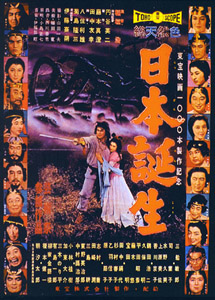 Jerry`s uncle Kisaku Ito did production design and sets for numerous plays and movies, including Toho`s all-star 1000th production THE THREE TREASURES. © 1959 Toho Co., Ltd.
Jerry`s uncle Kisaku Ito did production design and sets for numerous plays and movies, including Toho`s all-star 1000th production THE THREE TREASURES. © 1959 Toho Co., Ltd.Jerry decided to stay in Japan, but he didn’t speak much Japanese and began taking courses at a language school. He also took some jobs dubbing films, and one of his first assignments was voicing the lead in the movie TEARS (Namida, 1956). Around this time he also had a small role in THE EMPEROR’S BED (Tenno no Bedo), a play which followed many years in the lives of the Emperor and the carpenter who built his bed. Jerry was asked to do the part in THE EMPEROR’S BED by another uncle, Kisaku Ito, who had designed the sets for the show. Kisaku Ito is regarded as one of the greatest artistic scene designers ever in Japan; in addition to countless stage productions he handled art direction and production designs for films like the Academy Award-winning (Best Foreign Language Picture) GATE OF HELL, TALES OF UGETSU (Ugetsu Monogotari, 1953), SAMURAI (Miyamoto Musashi, 1954), BARBARIAN AND THE GEISHA (1958), THE THREE TREASURES (Nippon Tanjo, 1959), and THE YOUTH AND HIS AMULET (Gen to Fudomyo-O, 1961). In the late 1920s, Kisaku Ito had visited his brother Michio in Los Angeles. During that visit he drew impressive color illustrations of LA landmarks like Little Tokyo, City Hall, and the Egyptian Theatre. An exhibition of these drawings was recently held in Japan. Now that he was in Japan, Jerry was reintroduced to Sakae Yamaguchi. He recalled, “I really didn’t get to know her until I went to Japan. Her family’s house was in Azabu, and my father’s house was in Azabu. She started to show me around in Tokyo, and after two years, we married.” Sakae explained that when she had last seen Jerry both of them were in serious relationships. After she returned to Japan, she had called off her engagement to concentrate on her dancing career. So when Michio asked Sakae to be his son`s tour guide, she and Jerry were two newly single people. Romance blossomed, and the couple married in December 1957. Unfortunately, back in 1927 Jerry’s father Michio had not registered his birth with the Japanese consulate. This caused several legal problems for Jerry and Sakae. The Japanese government saw Jerry as an American citizen rather than of both the US and Japan. Therefore he had no family register in Japan, and he could not be added to the register of Sakae’s family. Sakae could not use the last name ‘Ito’ on her passport, and their children David and Michele were legally considered Jerry’s alone. Despite these many headaches, the Itos would go on to have a long and happy marriage. Jerry appeared onscreen in director Kaneto Shindo`s GUYS OF THE SEA (Umi no Yarodomo, 1957), and received good reviews for his performance as an Arab in A TEXAN IN TOKYO (Tokyo no Tekisasujin, 1957), a film about a Hollywood cowboy star who makes a trip to Japan. The movie was directed by Motoyoshi Oda (GODZILLA RAIDS AGAIN), written by Shinichi Sekizawa (MOTHRA, KING KONG VS GODZILLA), and featured many of the top comedians of the time, including Tony Tani (MR. PU). “All these comedians were trying to out-do one another and I was out there in left field, so everybody zoomed in on my performance,” Jerry remembered.
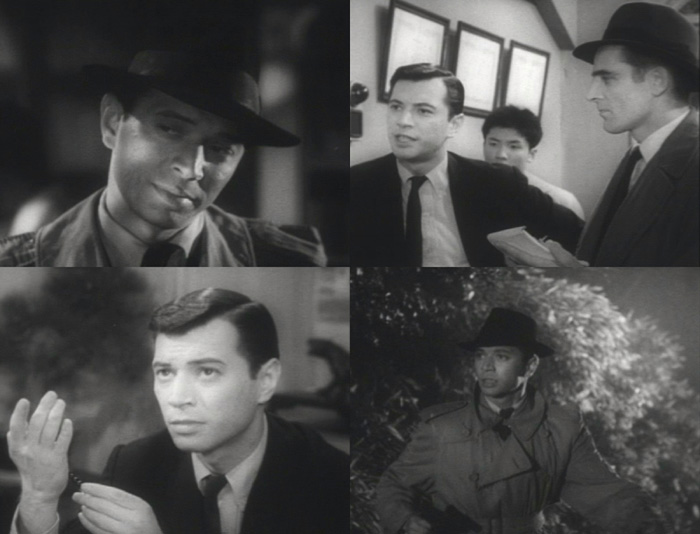 Jerry Ito as Police Superintendent Aida in the Japanese/American co-production THE MANSTER. © 1958 United Artists of Japan, Inc.
Jerry Ito as Police Superintendent Aida in the Japanese/American co-production THE MANSTER. © 1958 United Artists of Japan, Inc.Around that time, both Toho and Shochiku Studios offered Jerry a contract. Since Jerry was a stage trained actor, Michio Ito recommended that his son go with Toho since they owned the most playhouses. Jerry signed with Toho’s stage division but ended up being loaned out for movies at Toho, Daiei, Shochiku, and Toei because there weren’t many English-speaking actors in Japan at that time. “So many things changed in my life. For the 40 years I was in Japan, I never went to an audition. I used to do that in New York, but never in Japan.”
In 1958, Jerry was cast in an English language horror film which was shot in Japan by a joint Japanese and American crew. Produced by United Artists of Japan, the movie was filmed and marketed internationally with the English title THE SPLIT, released in Japan in July 1959 as THE TWO-HEADED KILLER (Soto no Satsujinki), and finally made it to America in March 1962 as THE MANSTER. THE MANSTER was the first of the “thing with two heads” genre that would later include titles like THE INCREDIBLE TWO-HEADED TRANSPLANT (1971) and the dark comedy HOW TO GET AHEAD IN ADVERTISING (1989). The film was written and co-directed by George Breakston, a former child actor who had appeared in MGM’s long-running Andy Hardy film series. In THE MANSTER, British actor Peter Dyneley (THUNDERBIRDS) played Larry Stanford, an American reporter stationed in Japan. While on a routine assignment, Stanford is drugged by mad scientist Dr. Robert Suzuki (Tetsu Nakamura), who injects the reporter with an experimental serum. Over several days, Stanford begins to change both physically and mentally, becoming sullen and violent. He wanders the streets at night committing murders which are investigated by Police Superintendent Aida (Jerry Ito). Stanford grows a second, monstrous head which eventually splits from his body as a strange, apelike creature.
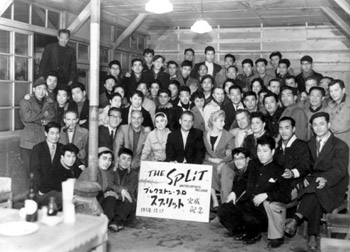 Cast and crew photo for THE MANSTER. Jerry Ito is standing on the far right. From the private collection of Jerry Ito. © 1958 United Artists of Japan, Inc.
Cast and crew photo for THE MANSTER. Jerry Ito is standing on the far right. From the private collection of Jerry Ito. © 1958 United Artists of Japan, Inc.While rarely seen in the United States for many years, THE MANSTER made an impression on many monster movie fans thanks to pictorials in magazines like Famous Monsters of Filmland that included the movie’s iconic image of star Peter Dyneley with an eye growing out of his shoulder. Decades after the movie was released, that scene inspired a sequence in director Sam Raimi`s third Evil Dead film, ARMY OF DARKNESS (1992), in which Bruce Campbell’s character Ash experiences a very similar split into good and bad versions. Jerry Ito continued to alternate between movie and stage productions. One division of the Toho Company handled cabarets and nightclubs, and in 1958 they asked Jerry to do some shows. He told them, “I don’t know nightclubs. I’m from the stage,” but Toho thought he would do well. His first nightclub show was with actress Koshiji Fubuki, a big star from Takarazuka who was a very famous chansons (French cabaret) singer in Japan. The show did very well, and the two would work together again in the early 1960s. On screen, Jerry played Sgt. March in HEY PINEAPPLE (Pineapple Butai, 1960), a drama about Japanese-American soldiers during WWII and the Korean War. He also appeared in a pair of Daiei movies, THE ATTACK OF JAN ARIMA (Jan Arima no Syugeki, 1959) and HEARTACHE AT 60 (Kanashiki Rokujyussai, 1961), before starring in what would become his most famous film.
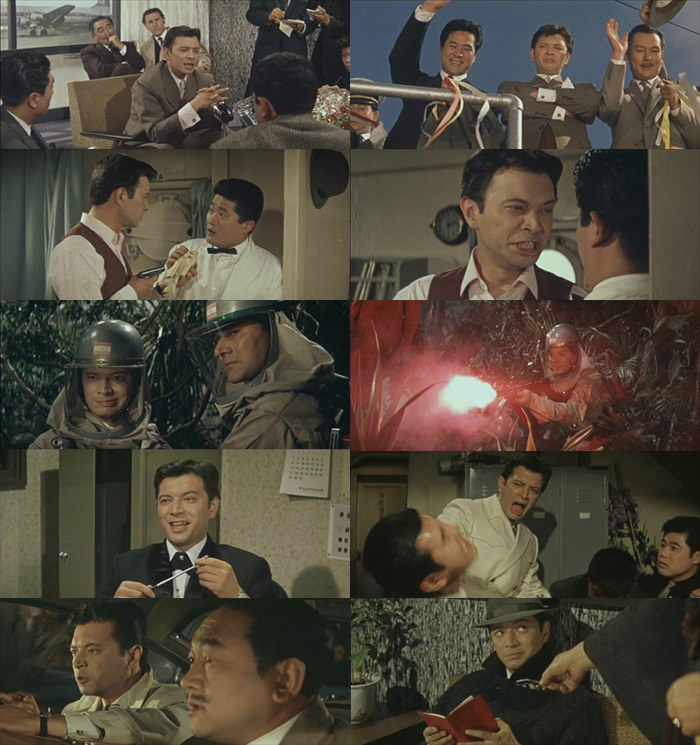 Jerry Ito in his most famous role; the evil Clark Nelson in MOTHRA. The character gave Jerry the opportunity to portray an utterly ruthless and despicable villain, and he played that part to the hilt. © 1961 Toho Co., Ltd.
Jerry Ito in his most famous role; the evil Clark Nelson in MOTHRA. The character gave Jerry the opportunity to portray an utterly ruthless and despicable villain, and he played that part to the hilt. © 1961 Toho Co., Ltd.During the 1950s, Toho produced several science fiction films such as GODZILLA (Gojira, 1954), GODZILLA RAIDS AGAIN (Gojira no Gyakushu, 1955), HALF HUMAN (Jyu-Jin Yuki Otoko, 1955), RODAN (Sora no Daikaiju Radon, 1956), and THE MYSTERIANS (Chikyu Boeigun, 1957). Most of these movies were box office hits in Japan that were quickly picked up for release in the United States and overseas. Columbia Pictures had acquired THE H-MAN and BATTLE IN OUTER SPACE (both featuring Jerry’s uncle Koreya Senda) and in 1961 the US studio agreed to co-finance and release Toho’s next monster movie, MOTHRA (Mosura).
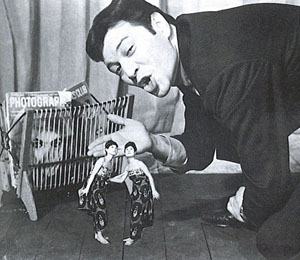 Clark Nelson (Jerry Ito) shows off his prize possessions (Emi and Yumi Ito) in a MOTHRA promotional shot. © 1961 Toho Co., Ltd.
Clark Nelson (Jerry Ito) shows off his prize possessions (Emi and Yumi Ito) in a MOTHRA promotional shot. © 1961 Toho Co., Ltd.MOTHRA was created by the team responsible for GODZILLA and most of Toho’s big fx films; producer Tomoyuki Tanaka, director Ishiro Honda, and special effects director Eiji Tsuburaya. Toho selected authors Shinichiro Nakamura (Procurer of Hell), Takehiko Fukunaga (The Deserted City), and Yoshie Hotta (Judgment) to write an early draft of the story entitled The Luminous Fairies and Mothra, which was serialized in the January 1961 issues of Weekly Asahi. The story was then assigned to screenwriter Shinichi Sekizawa, who completely reworked it into his own screenplay, deftly combining elements from previous Toho kaiju films with doses of comedy and fantasy. The cast of MOTHRA featured some of Toho’s top stars. The lead role of reporter “Bulldog” Junichiro Fukuda was played by Frankie Sakai, a popular actor and comedian who starred in Toho’s long-running Station Front film series. He was joined by Hiroshi Koizumi as Dr. Shinichi Chujo. Koizumi had starred in GODZILLA RAIDS AGAIN, and would go on to appear in many of Toho’s fx films, including reprising his MOTHRA role in 2003’s GODZILLA: TOKYO SOS (Gojira x Mosura x Mekagojira: Tokyo SOS). News photographer Michi Hanamura was played by Kyoko Kawagawa, a highly regarded actress from Akira Kurosawa films like THE BAD SLEEP WELL (Warui Yatsu Hodo Yoku Nemura, 1960) and RED BEARD (Akahige, 1966). Twin sisters Emi and Yumi Ito were cast as the Shobijin (Little Beauties), the tiny priestesses of Mothra. The Ito sisters (no relation to Jerry) were an extremely popular singing duo known as The Peanuts who had recorded several hits on Columbia Records’ Japanese label. Jerry Ito had the pivotal role as the film’s villain, Clark Nelson, the greedy entrepreneur who kidnaps the Shobijin from their home on Beiru Island (renamed Infant Island in later films) and forces them to perform in his “Secret Fairies Stage Show” in Japan. Nelson gave Jerry the chance to play a ruthless and despicable classic-style villain; when the character isn’t snarling and sneering at his “inferiors” his face usually bears a self-satisfied smirk. In their quest for riches, Nelson and his henchmen (including Jerry`s MANSTER co-star Tetsu Nakamura) kill several people, kidnap two women, beat up a child and cause untold millions in property damage. When Nelson is cornered by police at film`s end, his last act before being gunned down is to steal an old man’s cane. Jerry Ito recounts his mother`s reaction to MOTHRA
As originally written, Clark Nelson was supposed to meet a different fate. While fleeing Japan by plane, Nelson and his men would crash in the Daisetsuzan mountain range of Hokkaido. There they were found by Mothra, who forced the villains off a cliff to their deaths. Jerry Ito and the other actors filmed this sequence on location, but it was scrapped when Columbia Pictures offered additional money for a new ending in which Mothra attacks an American-style city. Toho complied, and set the finale in New Kirk City in Nelson’s fictional home country of Rolisica.
 Photo and production art showing the unused original ending for MOTHRA, in which Nelson and his henchmen fall to their deaths after being forced off a cliff by the monster insect. The scenes with Jerry Ito and the other actors were shot, but the ending was changed before the fx scenes were filmed. © 1961 Toho Co., Ltd.
Photo and production art showing the unused original ending for MOTHRA, in which Nelson and his henchmen fall to their deaths after being forced off a cliff by the monster insect. The scenes with Jerry Ito and the other actors were shot, but the ending was changed before the fx scenes were filmed. © 1961 Toho Co., Ltd.Years later, director Ishiro Honda remarked in an interview that Jerry’s Japanese was “truly terrible” at the time MOTHRA was made but the actor was “a very bright man.” Jerry recalled that during filming Honda— who had intended to make dramas for a female audience— told him he didn`t really want to be pigeonholed as a monster movie director. But MOTHRA was a tremendous box office success, and as the 1960s progressed Honda was increasingly assigned kaiju and fx films. One of Jerry Ito’s greatest benefits from MOTHRA was a friendship that would last the rest of his life. While enemies onscreen, Jerry and actor Hiroshi Koizumi became close friends in real life. In 2004, Jerry said, “Hiroshi Koizumi was a very good friend of mine. He was a real film buff. He was an NHK announcer, that’s how he started out. I played in many stage shows that he was in and we had a good time.” Koizumi`s own words can be read among the personal reminiscences following this tribute. Jerry Ito discusses MOTHRA and working with Hiroshi Koizumi
Later in 1961, Jerry was seen in Toho’s THE LAST WAR (Sekai Daisenso). Directed by Shuei Matsubayashi (THE STORM OF THE PACIFIC) with fx by Eiji Tsuburaya, THE LAST WAR was told from Japan’s point of view as a nation helpless to prevent escalating tensions between two nuclear superpowers (unnamed, but clearly representing the United States and Russia) from starting World War III and annihilating all of mankind. The film starred Akira Takarada (GODZILLA) as Takano, a merchant marine in love with the daughter (Yuriko Hoshi) of chauffeur Mokichi Tamura (played by MOTHRA’s Frankie Sakai) and his wife Oyoshi (Nobuko Otowa, the highly regarded actress from THE THREE TREASURES, ONIBABA, and OSHIN). Jerry has a small part as Watkins, a western member of the press corps.
While Jerry`s screentime in THE LAST WAR was rather brief his scenes are very effective, particularly for those familiar with Toho`s actors and movies. He shares a good moment with Frankie Sakai in which his character Watkins is disturbed by radio reports of the sabre rattling and threats being tossed back and forth by opposing nations, but Sakai`s Mokichi naively (and wrongly, it turns out) believes everything will work out and life will go on as it always has. Mokichi`s jovial nature eventually brings a smile to Watkins` face, and the scene plays as a nice contrast to Ito and Sakai`s roles in MOTHRA. Watkins also questions Takano about some strange lights in the sky that the merchant marine saw while at sea. Takano`s description leads Watkins to believe the sailor witnessed a secret test of a new sodium-based bomb. What makes this scene stand out is that both Jerry Ito and Akira Takarada begin their conversation in English before switching to Japanese, giving viewers a rare opportunity to hear both actors speaking English on film with their own voices rather than being dubbed. In another scene with Jerry and Frankie Sakai, Watkins tells Mokichi he is going to fly over the 38th Parallel (Korea), where things are heating up. He also mentions that a Summit is due to take place in Paris, and hopes that war can be avoided. Later in the film, Mokichi says to his wife, "I wonder if Watkins made it". Immediately after, the first nuclear warheads are used by jets at the 38th Parallel, and the film shows images of charred bodies reduced to dust blowing away across the battlefield. Watkins does not appear in the sequence, but is not seen or made mention of again in the film. THE LAST WAR received good notices in Japan and was named one of the Top 20 films of 1961 by the prestigious magazine Kinema Jumpo. It was picked up for US distribution by Brenco Pictures Corp., who released the movie directly to television in 1964. While THE LAST WAR has not been broadcast in America for decades, Brenco’s edit is remembered today for its inclusion of the famous Disney song “It’s A Small World” as well as an excerpt from John F. Kennedy’s September 25, 1961 speech to the United Nations in which the President declared, “Mankind must put an end to war, or war will put an end to mankind.”
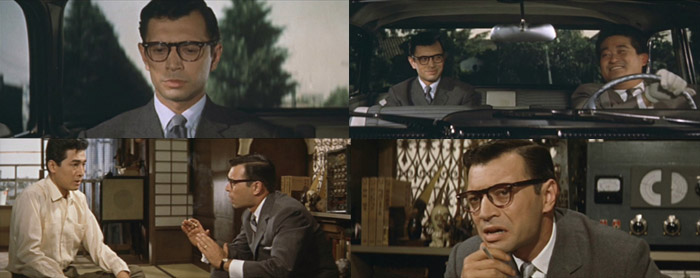 Jerry jokes with his MOTHRA co-star Frankie Sakai and questions Akira Takarada about military tests of a new type of nuclear bomb in the apocalyptic tale THE LAST WAR. © 1961 Toho Co., Ltd.
Jerry jokes with his MOTHRA co-star Frankie Sakai and questions Akira Takarada about military tests of a new type of nuclear bomb in the apocalyptic tale THE LAST WAR. © 1961 Toho Co., Ltd.Jerry Ito and Akira Takarada became good friends while making THE LAST WAR. When Takarada started an acting school, Jerry’s wife Sakae became one of the instructors, teaching dance movement. Akira Takarada also visited the Itos at their home after they moved to California in the late 1990s.
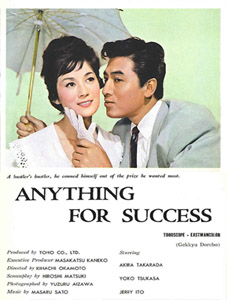 Yoko Tsukasa and Akira Takarada in English advertising materials for ANYTHING FOR SUCCESS, one of the films Jerry Ito starred in at Toho. © 1962 Toho Co., Ltd.
Yoko Tsukasa and Akira Takarada in English advertising materials for ANYTHING FOR SUCCESS, one of the films Jerry Ito starred in at Toho. © 1962 Toho Co., Ltd.The two friends worked together again in ANYTHING FOR SUCCESS (Gekyu Dorobo, 1962). In this romantic comedy, Takarada played Yoshimoto, a rising employee of the Crown Camera Company. When Yoshimoto learns that a rival company is negotiating for a major sale of cameras and equpment to a wealthy foreigner named Jose Dagon (Jerry Ito), the young salaryman comes up with a scheme to get the deal for Crown Camera. Yoshimoto convinces Dagon that they were college buddies, and Dagon agrees to buy from Crown… but problems arise when both men fall in love with the same woman (Yoko Tsukasa), a nightclub hostess Yoshimoto had hired as part of his ruse. Jerry had a supporting role in THE IRRESPONSIBLE RASCAL OF JAPAN (Nippon Musekinin Yaro, 1962), the first of three sequels to the comedy hit THE AGE OF IRRESPONSIBILITY IN JAPAN (Nippon Musekinin Jidai, 1962) with Hitoshi Ueki of the Crazy Cats and popular actress Reiko Dan. RASCAL was followed by INTERPOL CODE 8 (Kokusai Himitsu Keisatsu: Shirei Dai Hachigo, 1963), the start of Toho`s International Secret Police movie series which starred Kumi Mizuno (MONSTER ZERO), Akiko Wakabayashi (GHIDORAH THE THREE-HEADED MONSTER, YOU ONLY LIVE TWICE), and Tatsuya Mihashi (SECRET OF THE TELEGIAN) as Agent Kitami. Mihashi returned for four more International Secret Police films including KEY OF KEYS (Kagi no Kag, 1964), the movie that Woody Allen dubbed and reworked into WHAT’S UP TIGER LILY? (1966). In 1963, Jerry also appeared in THE ELEGANT LIFE OF MR. EVERYMAN (Eburi Manshi no Yuga-Na Seikatsu), directed by Kihachi Okamoto (DESPERADO OUTPOST) and starring Keiju Kobayahi (SUBMERSION OF JAPAN, RETURN OF GODZILLA), Akihiko Hirata (GODZILLA), Toki Shiozawa, and Hideyo Amamoto (KING KONG ESCAPES). The film was a salaryman comedy— a popular genre focusing on Japan`s working class— about an average guy (Kobayashi) who begins writing a magazine novella based on his own life. The German festival Berlinale hailed THE ELEGANT LIFE OF MR. EVERYMAN as a "masterpiece, overflowing with wisdom" that "expressed the scars of World War II at every turn".
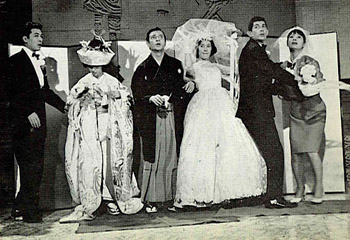 Akira Takarada (l), Jerry Ito (center), and Akiko Wakabayashi (r) in WALLEYED NIPPON. © 1963 Toho Co.
Akira Takarada (l), Jerry Ito (center), and Akiko Wakabayashi (r) in WALLEYED NIPPON. © 1963 Toho Co.The comedy WALLEYED NIPPON (Yabunirami Nippon, 1963) had Jerry in the title role as John Machihei, a Japanese/American professor who comes to Japan to experience its culture firsthand... and to find a traditional Japanese wife. Despite assistance from reporter Shin Moriyama (Akira Takarada), Machihei is stunned to find that Japan embraces both the old traditions and the new ways of the western world— looking both East and West at the same time— and is unable to choose between a traditional woman he expected to find or a more modern-style woman. Both men fall in and out of love with a pair of beautiful women before Machihei finds his true bride. Jerry`s co-stars included Yumi Shirakawa (star of RODAN and THE H-MAN) and Akiko Wakabayashi. Around this time, Jerry Ito worked once again with Emi and Yumi Ito, writing the English lyrics for a song that was recorded by The Peanuts and released in the United Kingdom and Europe. He also played Mr. McLeager in YOU CAN SUCCEED, TOO (Kimi mo Shusse ga Dekiru, 1964), a musical comedy about tour companies competing for business from foreigners coming to Japan for the 1964 Tokyo Olympics. The film is known for having big, American-style musical numbers on lavish, large scale sets. YOU CAN SUCCEED, TOO co-starred Frankie Sakai and KING KONG VS GODZILLA cast members Ichiro Arashima (THE LOST WORLD OF SINBAD), Tadao Takashima (ATRAGON, FRANKENSTEIN CONQUERS THE WORLD), and Mie Hama (KING KONG ESCAPES, YOU ONLY LIVE TWICE). In the mid-1960s Toho offered Jerry his own nightclub show and for several years he performed at different venues in Japan. “It took me years to find out what were the best songs to do,” Jerry said. “Most of the songs I did were from films that had played in Japan… a lot of screen music.” The audience for his shows was mostly men, so Jerry had four female performers join him for song and dance numbers. “You know, the wife stays home, and there were hostesses in the club. So I needed some women dancers on stage.”
In 1968, Tsuburaya Productions made the television series MIGHTY JACK (Maitei Jyakku), which followed the exploits of a team of specialists assembled by the United Nations to defeat the evil organization called Q. The show ran for thirteen hour-long episodes, and was followed by a second season, FIGHT! MIGHTY JACK (Tatakae! Maitei Jyakku), which had twenty six half-hour shows. Jerry Ito guest starred in the final two-part story, “Fly to the Hopeful Skies”. He played Roberto Okamura, a writer for World Magazine who befriends members of the Mighty Jack team but is actually an undercover agent for Q seeking to destroy them. Nearly twenty years after the two series were first aired in Japan, Sandy Frank Enterprises picked up the US rights. The first episode of MIGHTY JACK and the last two episodes of FIGHT! MIGHTY JACK were dubbed in English and edited together into one movie which was released on VHS and to American television in 1987 by King Features Entertainment. In 1991, The Sandy Frank version of MIGHTY JACK became Episode 314 of Comedy Central’s cult classic MYSTERY SCIENCE THEATER 3000, where the show’s characters Joel Robinson, Crow, and Tom Servo compared Jerry Ito to Frank Sinatra.
Jerry was also a recurring guest on a popular Japanese television series called THE MORNING SHOW, where he often performed new songs. “You could pick the composer and lyricist, any song you wanted to do, but it had to be new. I did many of those. And I did one song, “There’s No One at the Sea”, that became very popular on that show, and I decided to record it.” The song was intended to be part of an album of top tunes from THE MORNING SHOW, but the project never came to fruition. Later on, Jerry gave the boy and girl musical act Moi et Toi (Me and You) permission to record “There’s No One at the Sea”, and Koshiji Fubuki recorded it as well. Both became big hits. Jerry later signed with Toshiba Records and recorded several albums. He eventually did his own version of the song but it was not nearly as successful as the previous versions. He later remarked, “So I discovered this song, but it was a hit for somebody else. [Laughs]” During the 1970s, Jerry was a popular guest on TV talk shows and became well known for his stylish appearance and fashion sense. He appeared in commercials and print ads for products such as Ralph Lauren’s clothing line and Lea and Perrins foods, and began performing as a singer on cruise ships. Live performances and commercials became his main source of income, though he still continued to act periodically on television. Jerry returned to the big screen with GOLGO 13: ASSIGNMENT KOWLOON (Golgo 13: Kuron no Kubi, 1977), Toei`s feature film based on the long-running manga series Golgo 13 created by Takao Saito. Directed by Yukio Noda (ZERO WOMAN: RED HANDCUFFS), the movie starred international action star Shinichi “Sonny” Chiba (THE STREET FIGHTER, KILL BILL VOL. 1) as Golgo 13, a mysterious assassin who always makes his kill.
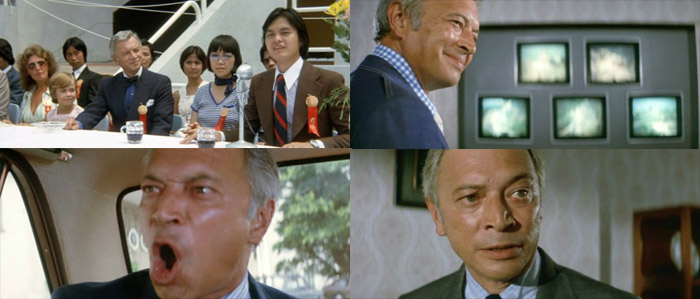 In GOLGO 13: ASSIGNMENT KOWLOON, Jerry Ito played a Hong Kong crimelord who is stalked by an unstoppable assassin. © 1977 Toei Co., Ltd.
In GOLGO 13: ASSIGNMENT KOWLOON, Jerry Ito played a Hong Kong crimelord who is stalked by an unstoppable assassin. © 1977 Toei Co., Ltd.In ASSIGNMENT KOWLOON, Golgo 13 is hired by Miami drug dealer Rocky Brown (Clayton) to kill Chow Lui Fung (Nick Lam Wai Kei), a Hong Kong crime lord who has been skimming from a major narcotics deal with the American. Golgo heads to Kowloon, Hong Kong, but before he can complete his assignment Chow is killed before his eyes by a female assassin. Staying one step ahead of police led by Detective Smithy (Callan Leung), Golgo eliminates his rival and learns that Chow was actually a front for the real kingpin of crime in Hong Kong; diplomatic consul Ange Polanski (Jerry Ito). The hitman tracks Polanski to his island headquarters and finishes the job he was hired to do. Polanski was another entertaining role for Jerry Ito. The character initially seems to be nothing more than a typical politician living abroad with his young daughter, but as GOLGO 13: ASSIGNMENT KOWLOON progresses his darker side becomes increasingly clear. Polanski is a different type of villain than MOTHRA’s Clark Nelson but no less treacherous; he murders, betrays his partners in crime, and even sleeps with Chow’s beautiful wife Lai Dut (Danna Nick).
The following year, Jerry was also part of the main cast for the super-hero television series UFO WAR: FIGHT! RED TIGER (UFO Daisenso Tatakae! Red Tiger, 1978). Produced by Soeisha, Ltd., the show ran for 37 episodes from April 8 to December 28, 1978. Jerry’s final film was MESSAGE FROM SPACE (Uchu Kara no Messeji, 1978), a large-scale space fantasy directed by Kinji Fukusaku (THE GREEN SLIME, BATTLE ROYALE). The movie was produced by Toei in the wake of the phenomenal worldwide success of the original STAR WARS (1977), and featured an international cast headlined by Vic Morrow (BLACKBOARD JUNGLE, COMBAT!, THE BAD NEWS BEARS) and Sonny Chiba. Much as STAR WARS had been inspired by mythology, old serials, and Japanese films like THE HIDDEN FORTRESS (Kakushi Toride no San-Akunin, 1958), MESSAGE FROM SPACE was very loosely based on the epic novel Satomi Hakkenden, which has been adapted numerous times for film and television, including Fukusaku’s 1983 version LEGEND OF THE EIGHT SAMURAI. In MESSAGE FROM SPACE, the peaceful planet Jillucia is conquered by the invading Gavanas, who are led by Rockseia XII (Mikio Narita) and his domineering mother Dark (played by Hideyo Amamoto in drag). Jillucian Princess Emeralida (Etsuko Shihomi) sends eight glowing seeds into space to find eight warriors who are destined to save her homeworld. The seeds choose an odd assortment of heroes that includes hard-drinking earthman General Garuda (Vic Morrow), overthrown Gavana ruler Prince Hans (Sonny Chiba), teenagers Aaron (Phillip Casnoff), Shiro (RING’s Hiroyuki Sanada), and Meia (Peggy Lee Brennan), plus Garuda’s robot sidekick Beba 2 (Isamu Shimizu). Jerry Ito played an unnamed general who yells at Garuda for wasting a precious military rocket to give his first robot, Beba 1, a burial in space. "You fool!” he yells. “A man like you should be terminated immediately!"
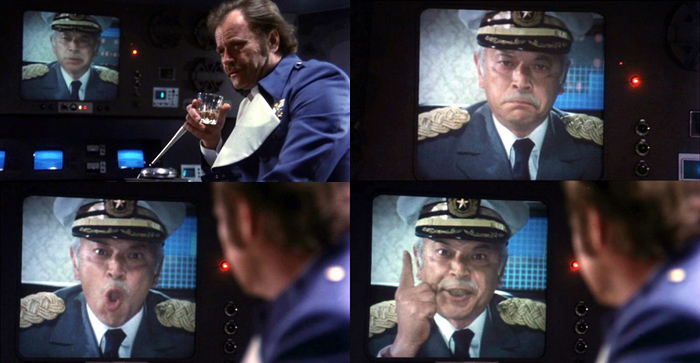 General Garuda (Vic Morrow) takes heat from his superior officer (Jerry Ito) in MESSAGE FROM SPACE. © 1978 Toei Co., Ltd./Tohokushinsha Film Co., Ltd.
General Garuda (Vic Morrow) takes heat from his superior officer (Jerry Ito) in MESSAGE FROM SPACE. © 1978 Toei Co., Ltd./Tohokushinsha Film Co., Ltd.That same year Jerry got to spend some time with an old friend; acclaimed actor Tony Curtis of SOME LIKE IT HOT and SPARTACUS fame. Curtis was in Japan to make THE BAD NEWS BEARS GO TO JAPAN (1978), the third and final film in the Paramount Pictures comedy series. Akira Takarada approached Jerry and asked if Tony Curtis would come to Takarada’s acting school and give a speech to the student body. Jerry passed along the request, and Curtis accepted. Tony Curtis` visit to the acting school led to an amusing meeting with Akira Takarada. Jerry recalled, “We went to the school, and we were sitting in the office. Tony is so direct…. he said to Takarada, ‘You were a major movie star, huh? And your career went down, so you opened up this school?’ And Takarada said, ‘Yeah, that’s what I did!’ I was so embarrassed!”
In late 1989/early 1990, Jerry signed a long-term contract with the Japanese public television system corporation NHK. He appeared in NHK-TV programs and had a semi-regular role on LET’S PLAY WITH ENGLISH (Eigo de Asobo), a children’s education show the debuted in April 1990. The series starred teen singer Miku Hanyu, and each episode would teach kids English with songs and animation. LET’S PLAY WITH ENGLISH ran for many years, but unfortunately Miku Hanyu died of lung cancer at age 30 in 2005. NHK-TV released several CD collections of songs from the show. In 1997, Sakae Ito visited her daughter Michele in Los Angeles to see an exhibit of photos of Michio Ito. While in Los Angeles she learned that Jerry had suffered a massive stroke and she rushed back to Japan to be with him. Jerry had lost the ability to speak, and the doctors felt the best method of rehabilitation would be for Jerry to relearn his native language, English. Since this could not be done in Japan, the Itos decided to move to Los Angeles to continue Jerry`s treatment and be closer to their children. Jerry began therapy at UCLA Medical Center’s Speech Pathology Clinic and, with much hard work and determination, he was able to recover. He became actively involved in a social club for “strokees”— other stroke victims— and helped counsel them. One of the techniques the UCLA doctors used for Jerry`s rehabilitation involved singing to relearn words. Jerry’s goal became to regain enough of his speech to truly sing again. He accomplished that goal, and in 2003 he recorded S’WONDERFUL, an album of standards such as “Fly Me to the Moon” and “Someone to Watch Over Me”. He also appeared at events for the Aurora Japanese Language Scholarship Foundation and began performing at gatherings for his stroke victims’ club. Jerry explained that he did this to help inspire other stroke victims and show them that recovery was possible. Will Viharo tells the Godzillafest audience of Jerry`s stroke recovery
For the last few years Jerry and Sakae enjoyed their retirement in Marina del Rey, California. They had a small dance studio in their home, and Sakae did private instruction in traditional Japanese dance. Jerry spent much of his time smoking his ever-present pipe, lounging by the pool with his neighbor Big Al, and enjoying college football, particularly his favorite team, USC.
The Itos also attended a few Godzilla/Toho themed events in California. In the summer of 1999 Jerry was a guest at G-Fest, where he was interviewed onstage by Monsters Are Attacking Tokyo author Stuart Galbraith IV and discussed the time he kissed Kumi Mizuno in INTERPOL CODE 8. In November 2004, the Itos traveled to San Francisco for Godzillafest, a week-long 50th anniversary celebration organized by Bay Area Film Events. The Godzillafest guest list included Russ Tamblyn (WAR OF THE GARGANTUAS), Jerry’s MOTHRA and THE LAST WAR co-star Ed Keane, Akira Kubo (SON OF GODZILLA, DESTROY ALL MONSTERS), Godzilla suit actor Tsutomu Kitagawa, and Jerry’s dear friend Hiroshi Koizumi. Saturday November 20 was a special MOTHRA night with Jerry, Ed Keane, and Hiroshi Koizumi on hand for the first screening of a newly-struck subtitled print of the 1961 classic, courtesy of Sony Pictures. Jerry’s daughter Michele later said that her father considered seeing MOTHRA again on the big screen, meeting with fans, and being with his old friends one last time to be the culmination of his movie career. Sadly, in December 2006 Jerry began to experience intense abdominal pains and in January of this year he was diagnosed with cancer. He began treatments at the Veterans` Hospital, but following an operation he suffered a series of small strokes that again affected his speech. After he contracted pneumonia and his condition worsened, Jerry`s family decided to bring him home so he could spend his remaining days with those he loved. Jerry Ito died at his son`s home on July 8, 2007. He is survived by his wife Sakae, children Michele and David, and his many grandchildren. With his passing, we have lost another piece of Toho`s Golden Age, that time when a seemingly neverending wave of strange and wondrous films were coming from Japan. But more than that, we have lost a man of good humor and kind heart, and a man who made the most out of life. May he rest in peace.
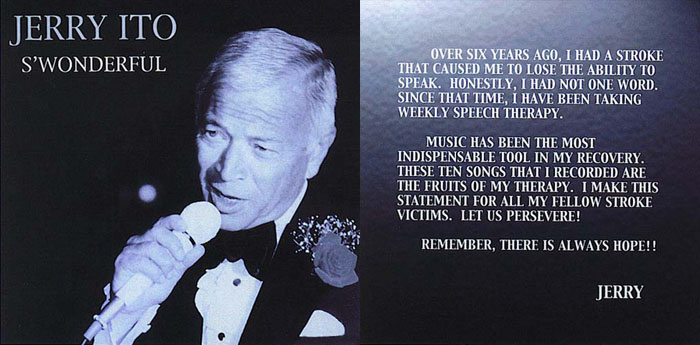 Jerry Ito`s album S`WONDERFUL contained an inspirational message for his fellow stroke victims. © 2003 Gerald Ito
Jerry Ito`s album S`WONDERFUL contained an inspirational message for his fellow stroke victims. © 2003 Gerald Ito_________________________________________________________________________________________________________
Friends and Fans Remember Jerry Ito...
??????????????????????????????????????????????????????????????? ????? ????????????????????? ???????????????????????????????? ???????????????????????????????????? ???? ????????????????????????????? ???????????????????????????????? ??? ????????????????????????????????????? ?????????????? ???????????????????????????????? ?? ??????????? ??????????????????????? Having learned that Mr. Jerry Ito has passed away, I am shocked and filled with deep sorrow. When I parted with him in San Francisco, we couldn`t utter a word but held each other firmly, and I will never forget the warm touch of his grip. When I performed with him in MOTHRA we got on very well, perhaps in part because we were about the same age. Later, when we worked together on Ms. Koshiji Fubuki`s show, we spent a month together in Osaka. We became best friends during the time we shared backstage. Jerry was a member of the famous Ito family and blessed with enormous talent and a special charm. He effused a rare blend of cheerful and active American-ness, and the manly and resolute qualities of the Japanese samurai. Embracing the memory of Jerry, a truly sophisticated gentleman, I pray for his soul from the bottom of my heart. - Hiroshi Koizumi, July 12, 2007
I first met Jerry Ito back in 1999 in Burbank, CA. He had recently recovered from a stroke and though his speech was slow, it still struck me as very eloquent and his deep voice still resonated. As fans took pictures with him and spoke with him, he was very gracious and when one fan asked if he could do the “Nelson Snarl” for their picture, he did so perfectly! When we organized Godzillafest at the Castro Theatre in San Francisco in 2004, I immediately contacted Mr. Ito about being a guest at the show. Little did I know that it would lead to some of the fondest memories of any of the Bay Area Film Events shows we’ve done. I had heard that Jerry had not seen MOTHRA co-star Hiroshi Koizumi in almost 30 years, but I did not realize how close a friendship they have had. When I picked up Jerry and Sakae Ito at the airport, the first thing Mrs. Ito asked was, “Is Mr. Koizumi here?” I told her he was at the hotel with the other guests. Their meeting at the hotel was a tear-filled, joyous reunion; one which I am sure will be covered elsewhere in this tribute. My main memories at the show itself all came on the night we showed MOTHRA and reunited Jerry Ito, Hiroshi Koizumi and Ed Keane. Before the movie started, most of the attention was on the Japanese guests. As the movie played, everyone was in the theater, watching the brand new print from Sony, which had never been through a projector before this. I made sure I was in the balcony towards the end of the film to take in the audience’s reaction when Nelson meets his demise. As Jerry Ito exits the car and shoves aside an old man, throwing his cane and then getting shot by the police, a thunderous applause came from the audience as fans cheered.
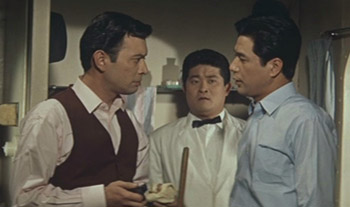 Jerry Ito faces off with Hiroshi Koizumi (and Frankie Sakai) in MOTHRA. The two actors were on hand for the first screening of Sony Pictures` new subtitled print of the Toho film at Godzillafest. © 1961 Toho Co., Ltd.
Jerry Ito faces off with Hiroshi Koizumi (and Frankie Sakai) in MOTHRA. The two actors were on hand for the first screening of Sony Pictures` new subtitled print of the Toho film at Godzillafest. © 1961 Toho Co., Ltd.Once the movie was over, Jerry was swamped with autograph seekers. Once realizing the impact he had in that film, everyone wanted to talk to him. As the first autograph seeker came up, I was helping at Jerry’s table and the fan handed me $20 for an autograph. I gave it to Sakae, Jerry’s wife. She asked, “What’s this?” and I told her it is money for Jerry’s autograph. She handed it back and said, “Oh no! You take it!” I refused, saying it was Jerry’s. As if on cue, Jerry reached out and jokingly grabbed the money. Sakae looked at him and said, “Oh, you are such a man!” We all had a good laugh and from there on, the fans kept filing in! The final memory was when I finally had some quiet time during one of the movies to sit down and spend time on the mezzanine with the Itos. They gave me a CD called “S’wonderful”. Sakae explained that when Jerry had his stroke, he lost his ability to speak. As part of his therapy, they would have him sing, so to help himself in the remarkable recovery he made, he cut a CD of standards… songs by Frank Sinatra, Dean Martin and others. I took the CD down to the theater and we played it as people were filing in to see MOTHRA that night. As Will Viharo, host of Thrillville, went onstage to introduce Jerry, being a big fan of the Rat Pack, he told the audience the story behind the CD and gave his own Rat Pack type tribute to Jerry Ito. It was an emotional part of the show and the audience responded enthusiastically. At this point, Jerry was a fan favorite amongst the guests we had at the show. He was always warm with the fans he spoke to and in reuniting with Koizumi and Keane, I hope he had as memorable experience with us as we did with him. He will be greatly missed and although he lived a long and eventful life, it still seems like it was cut short way too soon. -Bob Johnson
The first time I met Jerry Ito was back in 1999. He was a guest at G-Fest and I met him in the hotel lobby. I was very curious on what type of person Jerry might be. After all he played one of the slimiest characters I`d ever seen in Japanese films; Clark Nelson in MOTHRA. I walked up to him and introduced myself. He was so friendly and he wanted to sit down and chat. So we sat together and talked about everything from his role in MOTHRA to present day events. I was told by a friend that Jerry had health problems even back then and was amazed that he would want to make it to such an event. But I would assume Jerry loved what he did and it gave him great joy to meet his fans. The last time I was to meet Jerry was at Godzillafest 2004 in San Francisco. He was invited as a guest and was a part of the MOTHRA panel and screening of this rare film. Jerry was able to talk about his involvement in the film along with meeting old friends such as Hiroshi Koizumi and Ed Keane. It was great to see these old friends get together after many years. When the film was over, Jerry was mobbed for autographs. He was extremely touched by all this and it was great to see him get his due.
I brought my daughter along to the event and was not sure what she would think of all this. Needless to say, she had a ball. I introduced Jerry to her and she stayed by his side for about an hour. She was taking Japanese math skills and used an abacus, which is a Japanese calculator. Jerry was very intrigued by this and they worked with it for awhile. After her time with Jerry, I asked her how everything was going. She said she had fun with Jerry and that, ``He gets me". I don`t know what she meant, but I assume that she felt Jerry was a big kid and understood her at her level. The time I spent with Mr. Ito was short but rewarding. In real life, he was not the terrible Clark Nelson he played in MOTHRA, but Jerry Ito the kind and friendly film and stage performer we all met and admired. Thanks Jerry. We will miss you. -Loren “Butch” Portillo When I had the chance to meet Jerry Ito, it almost didn`t happen. I was late getting to my duties as a Godzillafest volunteer, and the night we screened MOTHRA I remember being very, very busy with people teeming about.
At one point though, during a screening of another film, I was able to settle down and chat with Mr. Ito for a while as my friend Clay and him discussed THE MANSTER. He was a very kind, gracious man that couldn`t believe a new generation of fans such as ourselves was deriving such enjoyment out of these films, but seemed genuinely glad we were. One thing that always sticks with me is that we were hoping Mr. Ito would get the same attention from our audience as some of our other guests. It wasn`t really looking that way from the autograph line early on...until we screened MOTHRA. When the audience realized that the infamous Nelson was in the very theater they were at, there was no stopping them afterwards! He became the audience darling, and we couldn`t have been more pleased with the results. I`m very proud to have met Jerry Ito, even if it was only for a few hours and to be able to tell him how much his career and characters brought enjoyment into the life of me and my family. He will be greatly missed. -Aaron Cooper I had the great pleasure of meeting Jerry Ito at G-Fest in 1999 and found him to be charming, knowledgeable, and enthusiastic about his involvement in the genre. I had a lot of fun asking him about the filming of MOTHRA. The next month, in August, I had the pleasure of meeting Hiroshi Koizumi. I distinctly remember asking him who some of his favorite actors to work with in the old days were, and Jerry Ito was among the names he mentioned. The world of kaiju movies has lost arguably one of the best villains in golden age Toho history. -John “Dutch” DeSentis Jerry Ito had suffered a stroke about a year before I first met him, and though he suffered no paralysis that I noticed, he had a hard time completing sentences, and struggled a bit to find the right words. This must have been incredibly frustrating for him, but he had a methodical determination to get the words out that was inspiring to watch. It wasn`t surprising when just a year or so later he had made such a dramatic recovery that his speech problems were almost unnoticeable.
Like a lot of Japanese entertainers of his era, Ito appeared in movies and on TV but his real passion was performing in front of a live audience. When invited to appear at his first Japanese fantasy film convention Ito was a bit trepidatious, and I remember he was a little bemused during his first few hours there, not quite sure what to make of the many fans who remembered him in movies like MOTHRA and THE MANSTER -- movies he made half a lifetime ago. As it turned out, Ito eventually came to enjoy the experience as much as fans enjoyed meeting him. It was therapeutic, his wife said, to nudge him in front of an audience again, and though he was a little self-conscious about the effects of the stroke, he was obviously pleased by the warm reception he received. He will be missed. -Stuart Galbraith IV Like many fans, my first memory of Jerry Ito was seeing him as Clark Nelson in MOTHRA. Toho’s monster movies were regularly shown on television when I was a kid, and I saw MOTHRA many, many times on Saturday matinees and the late, late show. Jerry certainly made an impression in that film; while Nelson pays the price for his actions he sure seemed to be enjoying himself until the end. Later I caught MESSAGE FROM SPACE on television and, thanks to video, I was finally able to watch more rarely seen films like THE LAST WAR and THE MANSTER. Jerry Ito became one of those faces I would see again and again in the Japanese fx movies, and that familiarity always added to my enjoyment of these films.
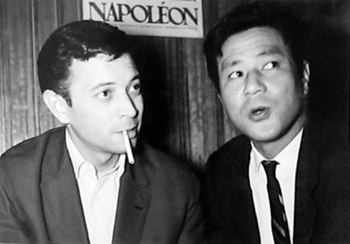 Jerry Ito and Hiroshi Koizumi hanging out in the early 1960s. From the private collection of Jerry Ito.
Jerry Ito and Hiroshi Koizumi hanging out in the early 1960s. From the private collection of Jerry Ito.Flash forward many years to 2004: In celebration of Godzilla’s 50th anniversary, Bob Johnson and the gang at Bay Area Film Events wanted to put together a major Toho-themed event, something bigger and (hopefully) better than what had taken place before in the US. The result was Godzillafest, a week-long film festival in San Francisco that included guests from Japan and America plus screenings of 20 different Toho movies. Sony Pictures had just struck a new 35mm print of the original Japanese version of MOTHRA, so it was a natural to premiere the new print at Godzillafest. It was also a natural to invite Jerry Ito to attend since he was now living in California. Bob made the arrangements to have Jerry and his wife Sakae as guests for the event. At the same time, David Chapple was handling all the details of sponsoring the guests from Japan. One of those guests was Hiroshi Koizumi, who had starred in GODZILLA RAIDS AGAIN, MOTHRA, MATANGO, GHIDORAH THE THREE-HEADED MONSTER, and many more Toho films, and whom David had known for many years. As Bob and others have mentioned, everyone knew that Jerry Ito and Hiroshi Koizumi had worked together on MOTHRA, but none of us were aware of how close friends the two men were. If I remember correctly, with the exception of a brief meeting at a Toho function in Japan, the two had not seen each other for decades, so both men were more than overjoyed to be together again. To his great credit, once Dave Chapple saw Jerry and Hiroshi Koizumi`s reaction upon seeing each other, he took it upon himself to make sure that the Itos were included in all the sightseeing trips, dinners, etc. that he had planned in advance for the Japanese guests. For the next few days, Jerry and Hiroshi were like a pair of kids, goofing around the city and remembering the good old days. Jerry had relearned both English and Japanese following his stroke, and Hiroshi teased him that his Japanese was as bad as ever.
When it came time for the Japanese guests to head for the airport for their trip home, David, August Ragone, and I were witness to a moment that I think will stay with me for the rest of my life. Jerry and Hiroshi Koizumi were clearly emotional as they said their goodbyes, but they were also trying to be “guys” about it and not let their feelings show too much. Instead they shook hands and looked each other in the eye without saying much. I was standing off to one side with Sakae Ito, and she turned to me and said, “They’re not young men anymore, and they know this is the last time they’ll see each other.” Her words hit me like a ton of bricks. I suddenly felt like I was intruding on something that had begun years before I was born and that was now coming to an end… but at the same time I felt blessed that life, fate, whatever you’d like to call it had allowed me to be there and witness this moment between two men whose work had been such a major part of my childhood. I later learned that the Itos lived a very short distance from my home, so in the years following Godzillafest I visited with them from time to time. Dave and I were the two Godzillafest crew members living in Los Angeles so we were the two the Itos took out to dinner as a ‘thank you’ for the event. On that night, Jerry showed us books and photos of his father and his uncles, of whom he was justifiably proud. He also brought out a videotape of a 1959 episode of THE DINAH SHORE CHEVY SHOW. This particular episode of the variety show introduced Americans to “entertainment from Japan”, and featured Japanese actors, dancers, and comics. Guest host Shirley MacLaine performed a comedy skit and a traditional Japanese dance number with her friend Wakana Hanayanagi…a.k.a. Sakae Ito. As Sakae danced on the TV screen, Jerry turned to me and beamed, “Isn’t my wife beautiful?” Only a fool would have disagreed. The last time I saw Jerry was in late December 2006, when Dave and I delivered a gift Hiroshi Koizumi had given to Dave in Japan. Jerry took sick barely a week after that visit, but I only learned of his illness a month or so before he passed. When I last saw him he looked happy and healthy, and I’m glad that will be image of Jerry I’ll carry with me for years to come. In closing, I’d like to thank everyone (both in Japan and the US) who helped with this tribute. A special thank you to Steve Ryfle for graciously sharing his unpublished interview with Jerry, and to Hiroshi Koizumi for answering my request for a personal message, and for sharing his own memories of the last meeting with his dear friend. My prayers go out to Jerry Ito, and my sympathy to his family and all those who loved him. -Keith Aiken
Some people touch you over the years; others leave an indelible impression on the first encounter. Jerry Ito was one of the few who did both for me. Shakespeare knew the value of a good villain - witness Richard III – and Jerry`s characterization of Clark Nelson in MOTHRA to me is on the same mythical level. Nelson knows the difference between good and evil and chooses evil. And for all that, we are fascinated by him and love to watch him pursue his wicked path, hoping all the while that he will be brought to justice in the end. I met Jerry Ito in person only once, on the final day of Godzillafest in 2004. He was seated next to Ed Keane, across the aisle from the Japanese guests, and I introduced myself. As Koizumi-san observes, his handshake was warm and firm, and the smile on his face and obvious joy at being there was unforgettable. I shared with him my above feeling about creating such an immortal villain in Clark Nelson, which caused him to beam. I also told him that it was one of my mother`s favorite films, and one of the few sci-fi or monster movies that she never minded us watching, probably because of the clear moral message of good and evil.
We then discussed his role in THE MANSTER, and his co-star Tetsu Nakamura. Jerry told me that Nakamura-san was a close friend, as they were both native English speakers (Nakamura was born in Canada to Japanese parents), and that he was also famous as a "toast-master" in Japan. Jerry was surprised and pleased to learn that there were not one, but two DVD reissues of THE MANSTER out. I left the theater briefly to purchase a copy at a local record store, which he was kind enough to sign for me. Jerry also spoke with me about his stroke, telling me "When I first woke up afterwards, I didn`t know my own name. I don`t mean I couldn`t say it, I didn`t know what it was." As my father had major surgery when I was very young, which left him unable to speak for several months, I have been told what it is like to have to re-learn how to speak. Jerry had made an incredible recovery. While his speech was a bit slow, his voice was very clear and distinct, and he had learned to shift almost unnoticeably in mid-sentence from a word that caused him difficulty to one with a similar meaning that was easier for him to pronounce. Mostly, I will remember Jerry Ito forever not as Clark Nelson, but as the warm and friendly gentleman I met at Godzillafest. Jerry made you feel that he was interested in what you were saying, and that he was delighted to be speaking with you. Nobody can ask for a higher compliment. Thank you Jerry, for your films, and the many memories you have left to all of us. -Clay Holden
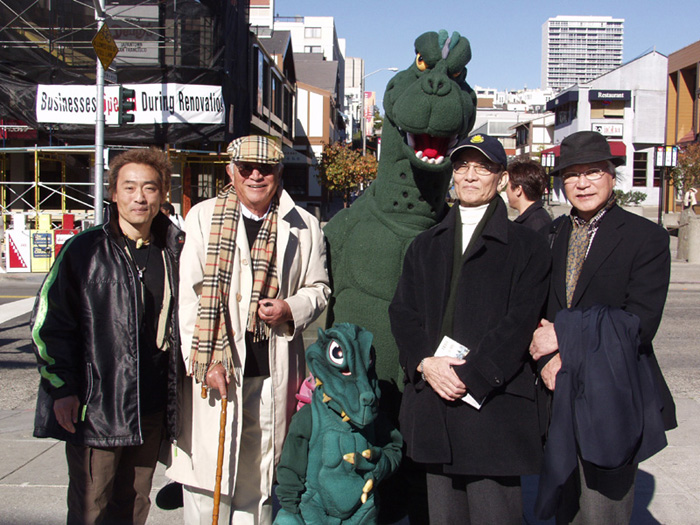 Godzilla and son join Tsutomu Kitagawa, Jerry Ito, Akira Kubo, and Hiroshi Koizumi in San Francisco.
Godzilla and son join Tsutomu Kitagawa, Jerry Ito, Akira Kubo, and Hiroshi Koizumi in San Francisco.


